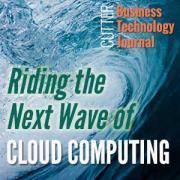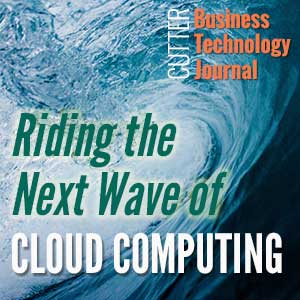Cloud computing is no longer the next big thing. It is the thing. Over the past decade, cloud computing has become the go-to solution for data storage and processing, even as data volume and complexity have grown by leaps and bounds. Cloud’s accessibility, low entry costs, and security features have enabled organizations of all sizes to become more agile and decrease time to market. Ultimately, the cloud provides organizations the means to stay competitive as they make significant strides toward their digital transformation goals.
Plus, the demand for and adoption of cloud computing services have increased at such a staggering rate that IT decision makers not opting for the cloud will soon need to justify — if they haven’t had to already — why they would not use the cloud as their first preference for data storage and processing needs.
As the title of this issue, “Riding the Next Wave of Cloud Computing,” implies, the cloud computing market has already achieved some major milestones since its inception. Yet it still remains one of the hottest markets in terms of growth, spending, and revenue generation. Indeed, it is still making its way up a steep growth curve, and as more features and functionality are added that allow businesses to embrace new business models and enable innovation, the growth shows no signs of slowing.
Public cloud allows organizations to tap into a virtually unlimited pool of data storage and processing power, remotely accessed and managed over the Internet, at a lower total cost of ownership than building and operating IT infrastructures themselves. However, the evolution of cloud technologies has not stopped at public clouds; community, private, multicloud, and hybrid cloud solutions are also viable means of storing and processing data, depending on an organization’s needs. A hybrid approach to cloud computing, for instance, which uses both public and private cloud resources, allows organizations to search for innovative business models and maximize their operational efficiencies without exceeding their IT budget.
However, as with any business model and process transformation, addressing the organizational culture and change issues to cloud computing are crucial to its success. This issue of Cutter Business Technology Journal offers astute evaluations from seven expert authors who outline various opportunities afforded by cloud computing solutions, myriad challenges that we face, and several strategies that will enable us to move forward successfully in our transformation journeys.
In This Issue
Many consider cloud computing’s foundation layer — infrastructure as a service (IaaS) — as a utility service, akin to electricity, showing physical similarities in the delivery of the two services. In our first article, authors Priya Sinha, Cutter Consortium Senior Consultant James Mitchell, Jonathan Smith, and David Wallom tell us that “understanding how power markets are structured gives valuable insight into future market development for cloud computing.” They leverage the analogy of the electricity market to explain how such features can be replicated for a global IaaS cloud computing market. The authors explore the benefits of the wholesale trading of contracts in delivering cloud services, how we can avoid the mistakes experienced by the electricity markets, and how we can leverage certain features of the electricity market that have led to increased competition, price transparency, and greater resilience to external shocks. Sinha et al. also examine the current state of the cloud computing market and explore how existing cloud market participants have tried to evolve the market.
Next, Prerna Lal discusses how the challenges of moving to a public cloud platform — performance concerns, control, compliance, and security threats — make the case for adopting a hybrid cloud strategy. This strategy entails moving some IT capabilities to the cloud, while maintaining core elements in-house, hosted on-premises. According to Lal, a hybrid model enables organizations “to optimally allocate their resources while keeping their current IT infrastructure operating at low risk.” She goes on to say that “a hybrid cloud strategy not only prepares an organization for the future but also protects its investment today.” Lal then describes the hybrid cloud market, its benefits, and a four-step process for designing a hybrid cloud strategy.
In our third piece, Łukasz Paciorkowski examines the “product as a service” transformation. He believes that “once products become cloud-connected…, organizations … can maintain a continuous dialogue with customers, provide additional services, and move from being ‘just a provider’ to an essential business partner.” Paciorkowski discusses the impact of product as a service on the business model; the implications for the product lifecycle, supporting processes, and organizational structure; and the inevitable changes to company culture and identity. Although he believes that “a cloud-delivered offering allows for rapid expansion to other markets and unprecedented growth of the end-customer base,” Paciorkowski also emphasizes the need to adjust your company culture to the cloud era to avoid the risk of failure.
In our final article, we hear from Cutter Consortium Senior Consultant Claude Baudoin, who takes a very useful and pragmatic view, with a look at lessons learned from the cloud journey to date. Those lessons include the shifting of costs from CAPEX to OPEX, the agility therein gained, the danger of shadow IT, improved rather than weakened security, the value of metrics, and the importance of keeping up with the evolution of cloud technologies. In concluding his lessons learned, Baudoin asserts, “It is now obvious that people who initially doubted the durability of the cloud phenomenon were wrong: the cloud has impacted business and IT much more completely than even the optimists thought possible.”
We hope the insight provided in this issue gives you an enlightened perspective on the current and future cloud computing market and the guidance required to make well-informed decisions on the strategies and technologies that will provide your organization a competitive edge.
Riding the Next Wave of Cloud Computing
Cutter Members: Read this issue of Cutter Business Technology Journal and explore the latest cloud computing strategies, technologies, and lessons learned!
Not a Cutter Member? Use Coupon Code CLOUD20 to SAVE 20% when you purchase this issue from the Cutter Bookstore!



